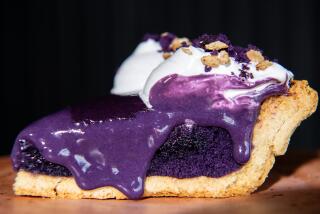Making Perfect Pie Crust Easy Task Sure to Garner Smiles of Approval
- Share via
Intimidated at the mere thought of making pie crust from scratch? You have lots of company. It seems to rank high on the cooking techniques phobia list.
Actually making pie crust is not that difficult. With a little practice, anyone can learn to make a picture-perfect pie with tender, flaky crust.
Begin by using either bleached or unbleached all-purpose flour. Unless the recipe directs you to sift the flour, measure by lightly spooning it into a dry measuring cup, then level off with a metal spatula. Measure carefully, being certain not to shake the cup or pack the flour down.
Salt may be added for flavor but is not necessary to the success of the recipe. Blend well with the flour before adding the fat.
Shortening, lard, butter, margarine or oil--any of these fats will give pie crust flavor and flakiness, in addition to promoting browning. Shortening is the most commonly used fat, and it creates a flaky texture but doesn’t impart much flavor. For extra-flaky pastry, chill the shortening 15 to 20 minutes before using. Lard adds flavor, creates a flakier texture than most other fats and may be used alone or in combination with shortening.
Unsalted butter is recommended over salted butter for baking. It gives both color and flavor to a pie crust. Margarine produces a crust similar to that of butter but without the butter taste. Both butter and margarine should be placed in the freezer 15 to 20 minutes before using and should be combined with shortening. Oil produces a tender pie crust but with a mealy texture.
A pastry blender with six to eight arched wires or blades attached to a handle (Photo 1) is recommended for cutting fat into the flour. If you don’t have a pastry blender, two table knives may be substituted, cross-cutting through the flour. It’s also possible to rub the fat and flour together with your fingertips, although the heat from hands can melt the shortening and may toughen the pastry.
As the fat particles are broken up, they become coated with the flour. Later, as the pie crust bakes, these melt. At the same time, moisture in the dough becomes steam and collects in the spaces left by the melting fat, producing a flaky pastry.
Because the moisture in flour varies, the amount of water combined with the flour-shortening mixture requires some judgment. Enough needs to be added to develop the gluten and hold the flour particles together but too much will cause the crust to become tough. Either cold or ice water may be used. The latter produces an extra-flaky pastry.
Future Back to Basics columns will be devoted to rolling out pie crust, fluting the edges and making double-crust and lattice-topped pies.
BASIC PIE CRUST
(For Single-Crust Pie)
1 cup flour
1/2 teaspoon salt, optional
1/3 cup plus 1 tablespoon shortening or 1/3 cup lard
2 to 2 1/2 tablespoons ice water
Combine flour and salt in medium bowl. Place shortening on top, then using pastry blender, cut shortening into flour (Photo 1) until particles are about size of small peas or coarse meal. Use relaxed flick of wrist, to keep dough mixture from becoming compact mass. If necessary, run finger across inside arc of pastry blender to release shortening.
Sprinkle cold water (Photo 2) 1 tablespoon at time, over flour-shortening mixture, tossing lightly with fork to distribute liquid evenly. As water is added, flour-shortening mixture will begin to hold together (Photo 3).
Mix only enough so dough sticks together, overmixing results in tough crust. When too much liquid is added, pastry becomes sticky, too little and pastry will be crumbly. When correct amount of water has been added, form pastry in ball (Photo 4) using hands. Roll out immediately or chill from 30 minutes to 2 days.
Requests for explanations of cooking techniques may be sent to Back to Basics, Food Section, The Times, Times Mirror Square, Los Angeles 90053.


